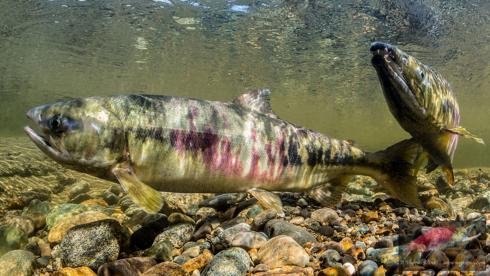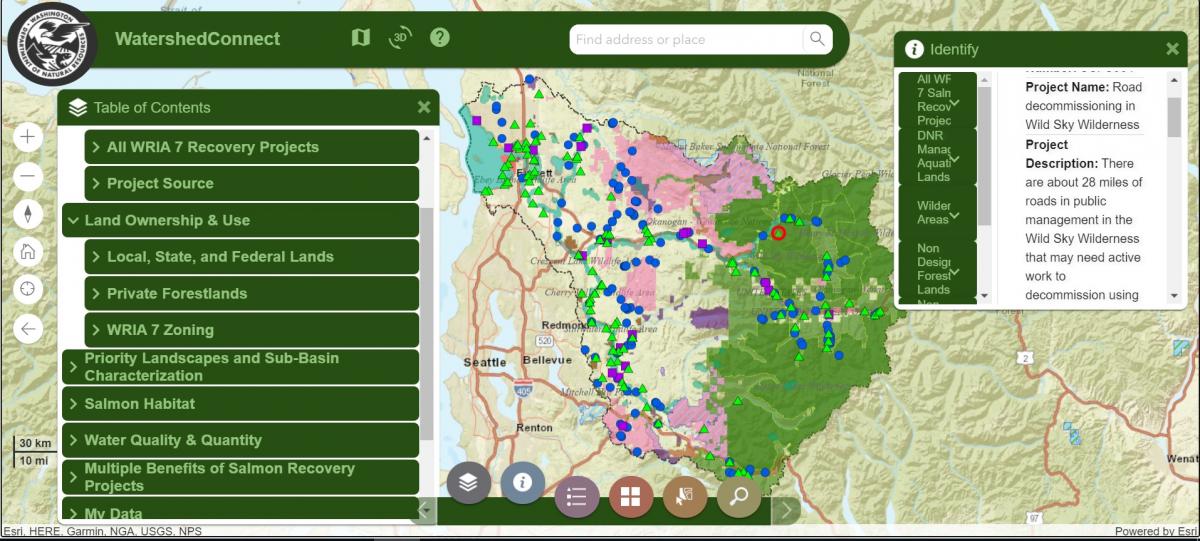WatershedConnect Tool
A Multiple Benefits Approach to
Salmon Recovery
To create more resilient landscapes that accelerate salmon recovery, we must enhance the number of restoration and protection projects being implemented on the ground and attract new audiences to support these projects. These are some of the reasons that the Washington State Department of Natural Resources (DNR) has created WatershedConnect.
WatershedConnect is an interactive mapping application that supports salmon recovery and habitat restoration by DNR and our partners. This engaging mapping tool also helps the public understand and visualize the multiple-benefits of salmon recovery projects, such as job creation, economic impacts, and environmental justice. WatershedConnect will help motivate new partners and target new funding by improving understanding of project-level needs in individual watersheds. Organizations that traditionally focus less on salmon recovery may find the addition of a co-benefits comparison helpful in understanding how they can benefit from salmon recovery projects.
The beta version of WatershedConnect focuses on DNR’s pilot watershed, the Snohomish Watershed (WRIA 7), and aggregates information on salmon recovery projects from our regional, state, tribal and federal partners for habitat connectivity, restoration, and landscape protection activities.
Click here: https://watershedconnect.dnr.wa.gov/
Using clear visual tools and plain language, users can learn about ways that salmon recovery projects support salmon while creating jobs and making environmental health more just. In this time when funding is particularly constrained, it is especially valuable to be able to identify those projects that get the most “bang for your buck.” WatershedConnect will help us do this.
Including cross-cutting issues and communicating about co-benefits in new ways, WatershedConnect will help us grow momentum and accelerate the delivery of projects that support salmon recovery, economic and health benefits, and climate resilience throughout the watershed.
Projects are grouped into three high-level categories:
- Restoration
- Protection
- Connectivity
PROJECT DATA
DNR used project data from multiple sources to create a WRIA 7 project database which is used to populate the map. We have included project data from the following sources: DNR programs; Snohomish Watershed Salmon Recovery Forum 4 Year Work Plan; Snoqualmie Basin 10 year work plan; United States Forest Service; Puget Sound Partnership Near Term Actions for the Snohomish Watershed.
Project data can be viewed by clicking on each project, including the following categories:
- Description of project
- Estimated cost
- Limiting factor(s) for salmon that would be addressed
- Amount of habitat benefit (if available – such as miles of stream opened, acres of habitat protected, miles of shoreline restored, tons of creosote removed)
- Project partners and sponsors
- Project phase
- Job creation per year (direct + indirect)
- Total economic effect
- Wages per year (direct + indirect)
- Environmental Health Disparities map rank (based on census tract where project is located using the Environmental Health Disparities map)
The map currently includes over 270 projects with implementation costs of approximately $275 million.
MULTIPLE BENEFITS AREAS EXPLORED
- Salmon benefit
- Job creation and economic output (using data from forthcoming economic impacts report by RTI International)
- Human health and environmental justice, based on location in overburdened communities (drawing on the Department of Health’s Environmental Health Disparities map)
- Climate resilience
- Water quality and quantity
INTENDED AUDIENCE
This map will be used with several key audiences including:
- DNR staff – What salmon projects are located on or near DNR lands to foster collaboration and partnership with other agencies, businesses, local governments.
- Legislature/decision makers – The scope of need for capital work/funding and locations.
- Funders (current or potential) – What kinds of salmon and habitat projects are needed and where partnership opportunities exist.
- Partners (current or potential) – What projects are located on or adjacent to their lands and where opportunities for cross-boundary partnerships exist.
- Existing salmon recovery community – To infuse new ideas about multiple benefits of salmon recovery work, including enhancing socio-economic and climate resilience benefits where appropriate.
NEXT STEPS
WatershedConnect is currently operating in a beta model. DNR can arrange demonstrations of the tool upon request. We expect to launch our 1.0 version in early 2022, including a full ESRI dashboard with a Project Comparison Tool function and additional features that will make it easy to track implementation of projects and the multiple benefits they achieve. The map will be maintained and updated over time as projects are completed or added, and to enhance the multiple benefits analysis.
The tool is intended to bring new partners and funders to help implement critical watershed habitat projects by communicating the return on investment and multiple benefits of projects. This tool is currently in beta form and we would appreciate your feedback.



